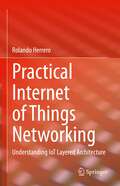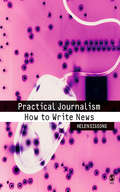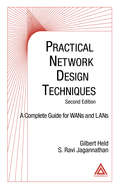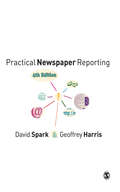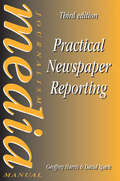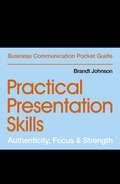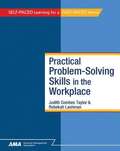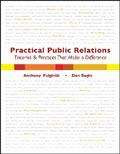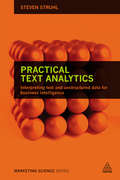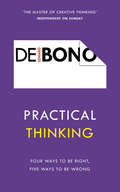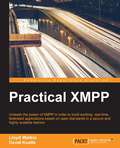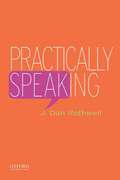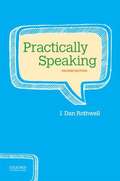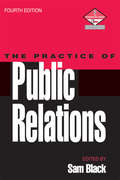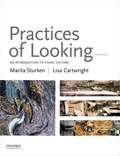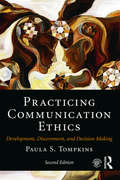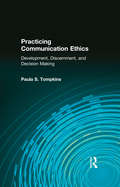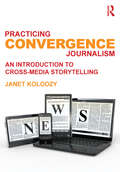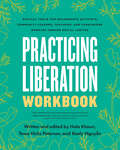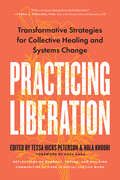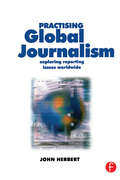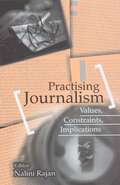- Table View
- List View
Practical Internet of Things Networking: Understanding IoT Layered Architecture
by Rolando HerreroThis textbook explores the different protocols and technologies that are key to supporting the most important Internet of Things (IoT) networking scenarios. Intended for upper undergraduate classes, the author presents these protocols and technologies from a perspective of the standard layered architecture with special focus on protocol interaction and functionality. To this end, the book provides a unique step-by-step hands-on approach that enables the reader to use common software tools and network emulators to understand, prototype, and deploy a vast range of use cases. The author shows how these topologies, which rely on standard physical layer technologies like LoRa, NB-IoT, LTE-M, IEEE 802.15.4 and BLE, provide end-to-end IPv6 connectivity and comply with the most important requirements of industrial IoT solutions. The book helps readers learn how to build IoT networks through exercises, lab projects, and examples.
Practical Journalism: How to Write News
by Helen SissonsPractical Journalism: How to Write News introduces the beginner to the skills needed to become a journalist in the digital age. The book draws on interviews with dozens of working journalists. They share their thoughts on the profession and we watch them work - selecting stories, carrying out interviews and writing scripts. There are chapters on interviewing, research techniques and news writing. Further chapters cover working in broadcasting and online. Media law and ethics are also included. Most journalists believe they work ethically although few have set rules and others admit to being pressured to behave underhandedly. This book looks at how journalists can work more ethically and provides a guide for beginners. The book is easy to read. Each chapter concludes with activities and a list of further reading. A glossary of terms is included at the end of the book.
Practical Models of Antenna Systems (Springer Aerospace Technology)
by Amur B. Khashimov Rinat R. SalikhovThis book discusses the principles of forming and analysis of mathematical models of a wide class of antenna systems, new scientific directions in the development and application of computational algorithms for the study of mathematical models for antenna arrays of radio navigating systems. The book is presented for specialists in antenna system design; it may be useful for students of radio engineering specialties. This book consequentially uses the asymptotic correspondence of two-dimensional and three-dimensional problems to antenna engineering, that includes the influence of the placement objects for a given limited class of problems. Rigorous electrodynamics formulations of models and the use of efficient numerical methods provide the reliability and accuracy of modeling.
Practical Network Design Techniques: A Complete Guide For WANs and LANs
by Gilbert Held S. Ravi JagannathanThe authors of Practical Network Design Techniques, Second Edition: A Complete Guide for WANs and LANs build upon the popular first edition by combining pre-existing network design fundamentals with new material on LAN devices and topologies, wireless local networks, and LAN internetworking issues.This new edition has two parts. The first p
Practical Newspaper Reporting (Media Manuals Ser.)
by Geoffrey Harris David B. SparkNow in its fourth edition, this classic textbook has grown up alongside the newspaper industry. Today, as ever, it provides students of newspaper journalism with a toolkit for gathering news and filling ever-increasing space with first-rate copy for print and online. Detailed and down-to-earth, this book delivers: * Guidance on news gathering, from government and business to sport and religion * Guidance on news writing, drawing on over 300 examples that have appeared in print, discussing why they work or how they could have been better * Guidance on feature writing, including profiles, comment, leading articles, obituaries and reviews * Specific chapters on ethical reporting and the possibilities and pitfalls of investigative journalism * A review of the new financial realities that the internet is imposing on the media. Informed by over half a century's professional experience and fully revised to give a nuanced account of the skills required in an online environment, this book is an essential companion for your journalism degree and beyond.
Practical Newspaper Reporting (Media Manuals Ser.)
by Geoffrey Harris David SparkThis guide to all aspects of the reporter's job, has been extensively revised and updated for a third edition. It considers:What is news?How the modern newsroom operatesHow facts are gathered and checkedThe reporter and picture ideasDistrict reportingTechniques of interviewingNews writing and newspaper languageHow to summarizeReporting the courtsPolitical and industrial reportingAspects of sportswritingFeature writing and arts reviewing The book also includes an important new chapter on the place of local government in newspaper coverage and it examines a newspaper's internal structure and the reporter's daily work in the light of the latest technology.This classic textbook is a must for all journalism and media courses and offers the ideal career introduction for the young journalist.
Practical Presentation Skills: Authenticity, Focus & Strength
by Brandt JohnsonDeliver compelling presentations in any context, from a meeting with colleagues to a client pitch or keynote address.Whenever you talk to anyone, you are presenting yourself and your ideas to an audience. You are giving a presentation. This could be in person, on the phone, or via videoconference. In any case, both your content and your delivery contribute to the vitality and effectiveness of your message. Too many speakers fail to engage their audience and get their ideas across. Don't be one of them! Practical Presentation Skills will help you master the three fundamental elements responsible for a presentation's success: authenticity, focus, and strength.
Practical Presentation Skills: Authenticity, Focus & Strength (Business Communication Pocket Guides)
by Brandt JohnsonDeliver compelling presentations in any context, from a meeting with colleagues to a client pitch or keynote address.Whenever you talk to anyone, you are presenting yourself and your ideas to an audience. You are giving a presentation. This could be in person, on the phone, or via videoconference. In any case, both your content and your delivery contribute to the vitality and effectiveness of your message. Too many speakers fail to engage their audience and get their ideas across. Don't be one of them! Practical Presentation Skills will help you master the three fundamental elements responsible for a presentation's success: authenticity, focus, and strength.
Practical Problem-Solving Skills in the Workplace
by Judith Combes Taylor Rebekah LashmanProblem-solving skills to identify and resolve work-related problems and improve job performance. With the increasing emphasis on initiative in the workplace, it‘s essential to know how to recognize, define, and analyze problems and then develop workable solutions to correct them. This book provides all the skills needed to achieve this, including a problem-solving tree. Readers will learn how to: • Evaluate your own problem-solving strengths and weaknesses • Use problem-solving skills to identify and resolve work-related problems and improve your job performance • Track the steps you need to solve work-related problems with the Problem-Solving Tree. This is an ebook version of the AMA Self-Study course. If you want to take the course for credit you need to either purchase a hard copy of the course through amaselfstudy.org or purchase an online version of the course through www.flexstudy.com.
Practical Public Relations: Theories and Techniques That Make a Difference
by Anthony Fulginiti Don BaginPublic relations is story telling. Persons and organizations have the right to tell their sides of the story. It's a constitutionally protected activity, like journalism and advertising. But public relations differs from journalism because it openly advocates for clients and organizations. And PR differs from advertising because it must earn, purchase, the reputation so important to organizations. Public relations practitioners are both counselors and communicators. They both fashion and send information persuasive messages to important audiences. They're responsible for maintaining the relationships between their organizations and their important publics.
Practical Text Analytics
by Steven StruhlBridging the gap between the marketer who must put text analytics to use and the increasingly rarefied community of data analysis experts, Practical Text Analytics is an accessible guide to the many remarkable advances in text analytics that specialists are discussing among themselves. Instead of being a resource for programmers, a book on theory or an introduction on how to use advanced statistical programs, this daily reference resource cuts through the profusion of jargon, evaluating the strengths and weaknesses of various methods and serving as a guide to what is credible in this fast-moving and often confusing field. Practical Text Analytics provides guidance on the application of text analytics for marketing professionals who must interpret the results and apply them in their campaigns. It presents the process of analysis in ways that people who use the data need to see them, helping marketers to clarify and organize confidently the confusing array of methods, frame the right questions and apply the results successfully to find meaning in any unstructured data and develop powerful new marketing strategies. About the series: The Marketing Science series makes difficult topics accessible to marketing students and practitioners by grounding them in business reality. Each book is written by an expert in the field and includes case studies and illustrations enabling marketers to gain confidence in applying the tools and techniques and in commissioning external research.
Practical Thinking: Four Ways to be Right, Five Ways to be Wrong
by Edward de BonoIn Practical Thinking de Bono’s theme is everyday thinking, how the mind actually works – not how philosophers think it should. Based on the results of his famous Black Cylinder Experiment (a critical thinking task that asks participants why they think a black cylinder falls over), de Bono explores the four practical ways of being right. From there he picks out and names the five levels of understanding – and the five major mistakes in thinking. From memes and Instagram to twitter and bestselling books like Mistakes I Made At Work, mistakes – and what we can learn from them – are a hot topic. With Edward you’ll learn exactly why we all make them.
Practical XMPP
by Lloyd Watkin David KoelleUnleash the power of XMPP in order to build exciting, real-time, federated applications based on open standards in a secure and highly scalable fashion About This Book * Learn about the fundamentals of XMPP and be able to work with the core functionality both server-side and in the browser * Build a simple 1-to-1 chat (the "Hello World" of XMPP), explore multi-user chat, publish subscribe systems, and work with a decentralized social network * Author Lloyd Watkins is a member of the XMPP standards committee Who This Book Is For If you want to learn about the fundamentals of XMPP, be able to work with the core functionality both server-side and in the browser then this book is for you.No knowledge of XMPP is required, or of TCP/IP networking. It's important that you already know how to build applications of some form, and are looking get a better understanding of how to implement XMPP for one or more of its many uses. You should be interested in the decentralized web, know HTML, and likely know JavaScript and NodeJS. You will probably know JSON, and hopefully XML (this is the native output of XMPP). What You Will Learn * Install and configure an XMPP server and use it to connect from a traditional desktop client and send a message * Build a simple server-side application that will respond to messages from our logged in desktop client * Install and run XMPP-FTW, connect to the server from the browser, and handle incoming/outgoing messages * Connect to a multi-user chat room, send/receive stanzas, add a room password, join a protected room, set the room's subject, and change a user's affiliation * Get to grips with the publish-subscribe extension of XMPP and use it to build a pusher system that can make any website real-time * Build a simple XMPP component and create an extension for XMPP-FTW that allows you to use your own custom format * Build an XMPP version of the classic game "Pong" In Detail XMPP (eXtensible Messaging and Presence Protocol) is a messaging protocol that enables communication between two or more devices via the Internet. With this book, developers will learn about the fundamentals of XMPP, be able to work with the core functionality both server-side and in the browser, as well as starting to explore several of the protocol extensions. You will not only have a solid grasp of XMPP and how it works, but will also be able to use the protocol to build real-world applications that utilize the power of XMPP. By the end of this book, you will know more about networking applications in general, and have a good understanding of how to extend XMPP, as well as using it in sample applications. Style and approach Through a number of hands-on projects, this book shows you how to build usable applications that highlights a feature of XMPP.
Practically Speaking
by J. Dan RothwellPractically Speaking is a brief text that covers the essentials of public speaking without sacrificing student interest or sound scholarship. Using a conversational and edgy style, author Dan Rothwell gives practical advice and a fresh perspective on classic and contemporary theories and research. This essential guide provides students with a solid foundation in public speaking and then teaches them how to add their own voices to the conversation.
Practically Speaking: Second Edition
by J. Dan RothwellWidely praised for its conversational tone and clear advice, Practically Speaking is the public speaking textbook your students will actually read. Filled with engaging stories and examples, sound scholarship and recent research, and useful tips and tricks, Practically Speaking shows students how to get started, practice thinking critically, and ultimately develop their own voice.
Practice Makes Perfect: English Conversation
by Jean YatesLearn how to speak English fluently and spontaneously Practice Makes Perfect: English Conversation gives you helpful instruction on correct pronunciation, grammar, syntax, and word usage, keeping in mind the typical problems of non-native English speakers like you. Each section includes a series of exercises that gives you extra practice in using new concepts and encourages you to construct personalized conversations. The lessons will reassure even grammar-phobic learners that you can achieve a confident speaking style. Offering a winning formula for getting a handle on speaking English right away, Practice Makes Perfect: English Conversation offers: Engaging dialogues illustrate practical conversational situations Example phrases or sentences clarify each point A variety of exercises for practice, with an answer key that provides instant feedback and reference Practical and high-frequency vocabulary used throughout
Practice of Public Relations
by Sam BlackPublic relations is an essential element in effective and successful business today. The theory of public relations does not change but the practice develops with new ideas and methods of management and business. This fourth edition of 'The Practice of Public Relations' incorporates essential updating and covers new areas such as: *international public relations *crisis management *sponsorship *education and training *career prospects. In 'The Practice of Public Relations' fifteen contributors give well-reasoned, practical introductions to every aspect of public relations. Keys to the many different ways in which public relations can contribute to the achievement of objectives and the successful and harmonious operation of an organization are given thorough coverage. TThis new edition has been prepared to embrace these changes so that CAM students and other readers are fully briefed on the latest issues in the realm of public relations. Sam Black, during his career, has played a significant role in the development of both the Institute of Public Relations and the International Public Relations Association. Contributors: John Cole-Morgan, Betty Dean, Rosemary Graham, Mark D Grundy, Jane Hammond, Brian Harvey, Danny Moss, Margaret Nally, Phyllis Oberman, Michael Regester, Douglas Smith, Tim Travers-Healy, Neville Wade, Sue Wolstenholme.
Practices Of Looking: An Introduction To Visual Culture (Third Edition)
by Lisa Cartwright Marita SturkenPractices of Looking, Third Edition, bridges visual, communication, media, and cultural studies to investigate how images and the activity of looking carry meaning within and between different arenas in everyday life. The third edition has been updated to represent the contemporary visual cultural landscape and includes topics like the increasingly rapid global circulation of media, the rise of design and DIY cultures, digital media art and activism, and challenges to photojournalism and news media. Challenging yet accessible, Practices of Looking, Third Edition, is ideal for courses across a range of disciplines.
Practicing Communication Ethics: Development, Discernment, and Decision Making
by Paula S. TompkinsPracticing Communication Ethics: Development, Discernment, and Decision Making presents a theoretical framework for developing a personal standard of ethics that can be applied in everyday communication situations. This second edition focuses on how the reader’s communication matters ethically in cocreating their relationships, family, workgroups, and communities. Through an examination of ethical values including truth, justice, freedom, care, integrity, and honor, the reader can determine which values they are ethically committed to upholding. Blending communication theory, ethics as practical philosophy, and moral psychology, the text presents the practice of communication ethics as part of the lifelong process of personal development and fosters the ability in its readers to approach communication decision making through an ethical lens.
Practicing Communication Ethics: Development, Discernment, and Decision-Making
by Paula S. Tompkins Kenneth E. AndersonPracticing Communication Ethics provides a theoretical framework for developing a personal standard of ethics that can be applied in real world communication situations. Through an examination of specific ethical values including truth, justice, freedom, care, and integrity, this first edition enables the reader to personally determine which values they are ethically committed to upholding. Blending communication theory, ethics as practical philosophy, and moral psychology, this text presents the practice of communication ethics as part of the lifelong process of personal development and fosters the ability in its readers to approach communication decision-making through an ethical lens.
Practicing Convergence Journalism: An Introduction to Cross-Media Storytelling
by Janet KolodzyPracticing Convergence Journalism teaches budding journalists how to make the most of digital technology to tell their stories effectively across multiple media platforms—in print, audio, video and online. Janet Kolodzy addresses multi-media and cross-media thinking, organizing, reporting and producing for both short-form spot news and long-form features. Her approach focuses on storytelling principles, not just specific technical practices, providing journalists with the mindset and skills they need to adapt their writing and reporting for the tools of today and tomorrow. With this book and the aid of its companion website, students learn how to: Develop a cross-media mode of journalistic thinking that will result in stories suitable for a fast-paced, multitasking and mobile audience. Decide when visuals are useful and necessary, and understand how to capture, select and organize them to effectively enhance a reader’s understanding of a story. Put together various elements of storytelling (writing, audio, moving and still pictures) for an interactive journalistic experience.
Practicing Liberation Workbook: Radical Tools for Grassroots Activists, Community Leaders, Teachers, and Caretakers Working Toward Social Justice
by Tessa Hicks Peterson Hala Khouri Keely NguyễnThe accompanying workbook to Practicing Liberation: essential skills, exercises, and journal prompts for social-change workers to protect boundaries, prevent burnout, and nourish organizational cultures of resilience and careWhat do you imagine a better world to look, feel, and sound like?Practicing Liberation Workbook shows that nourishing our movements and communities depends on nourishing ourselves—and that centering rest, prioritizing joy, and celebrating creativity and radical imagination is necessary for long-term change. To be sustainable and realize the transformation we&’re working toward, we need to care for our body, mind, and spirit, even (and especially) when the needs of our communities are urgent.In this accompanying workbook to Practicing Liberation, editors Hala Khouri and Tessa Hicks Peterson respond to the real needs of activists and changemakers—like healing from stress and burnout, processing grief and rage, and addressing overwhelm and disconnection. Examples of practices include:Guided journal prompts for self-care critical reflections: Reflect on the ideas and practices you&’ve inherited around survival and self-care. What did you learn about survival in your family of origin? What did you learn about self-care?Embrace and release, an embodied exercise to support you in times of overwhelmShared reflections for building community: What experiences or circumstances have shaped you in your life? What gifts has this given you? What can&’t you see about the world as a result? What support would give you more tools or uplift your gifts in this work?Meditations for self-forgiveness, equanimity, and connection with nature Holding space and being present for others through embodied listeningReaders are invited to try out the practices alone, with friends, in ceremony, at work, and in nature—to pick those that resonate most and use this toolkit in service of the care and transformation we each need to show up, sustain our work, and thrive for ourselves and our communities.
Practicing Liberation: Transformative Strategies for Collective Healing & Systems Change: Reflections on burnout, trauma & building communities of care in social justice work
by Tessa Hicks Peterson Hala KhouriHow do we do effective, sustainable social change…without burning out, internalizing systemic toxicity, or replicating urgency culture? A trauma-informed anthology with contributions from 13 activists and community organizers—for readers of adrienne maree brown, Staci K. Haines, and Ejeris DixonWhen your work is inextricable from your identity, your community, and your own liberation, you need a unique praxis of care to sustain it—and for mission-driven activists, organizers, and changemakers working under oppressive systems, making space to center vital needs like rest, self-care, and healthy boundaries isn&’t as simple as clocking out.Practicing Liberation reorients collective justice work toward a model that transforms the effects of injustice, harm, and oppressive systems into resilience, joy, and community care. Through frameworks like trauma-informed methodology, transformative movement organizing, engaged Buddhism, and healing justice, editors Hala Khouri and Tessa Hicks Peterson show readers how to:Embody healing, wellness, and beloved communityGuard against replicating systems of harmDisrupt racist, classist, anti-queer, and anti-trans behavior and systemsCelebrate creativity and radical imagination in movement workCenter healing from intergenerational trauma, white supremacy culture, and extractive capitalismHonor that self-care is a necessity—not a luxury—that strengthens our collectivesFeaturing essays from editors Hala Khouri and Tessa Hicks Peterson and contributors like Kazu Haga, Taj James, Nkem Ndefo, Jacoby Ballard, Sará King, Kerri Kelly, and more, Practicing Liberation can be used on its own or alongside The Practicing Liberation Workbook to help readers orient toward embodied leadership, interconnected collectives, and a bold vision for transformation—the vital tools we need for collective wellbeing, healing, and long-term social change.
Practising Global Journalism: Exploring reporting issues worldwide
by John HerbertFrom this book, you will gain an understanding of the global media marketplace - the technology, the players and the issues. The role of news agencies, sources and networks are explored covering the issues of ethics, global media ownership and control. Find out how journalists are using the web and learn even newer ways to collect and communicate information. Essential reading for today's practising and trainee journalists. John Herbert examines the global environment in which journalists operate and describes the latest technology and its impact on print, broadcast and online journalism practice.Practising Global Journalism is a unique overview of the profession, providing a comparative study of journalism practice worldwide. Case studies are drawn from Europe, Australia, the Asia Pacific, South Asia, China, Africa and the Americas.
Practising Journalism: Values, Constraints, Implications
by Nalini RajanPractising Journalism brings together experts from the field of journalism: journalists; freelance writers; lectures; and media practitioners to provide a comprehensive collection of current articles. Offering a unique view of the way journalism is both practiced and taught, this book is divided into four section: core values in journalism; specialisation within the craft; the constraints of practice and implications for the future. It covers areas including: gender and identity in the popular press; sports journalism; urban reporting; embedded journalism; censorship; and alternative media. This book is essential reading for students of journalism and all those considering a career in the field.
